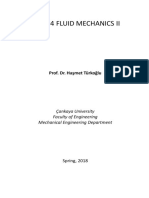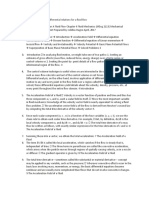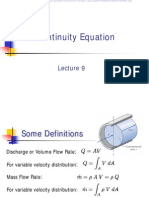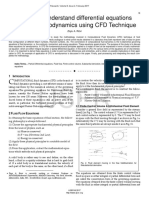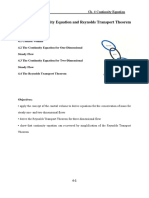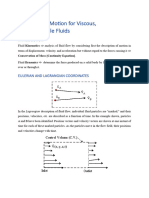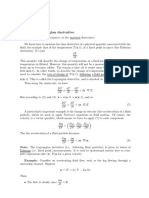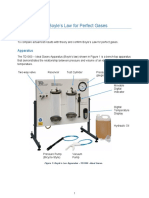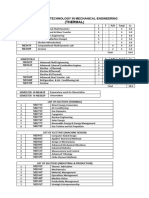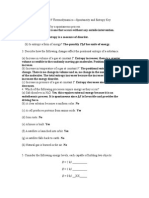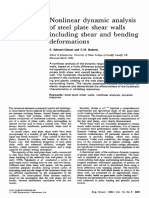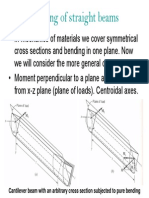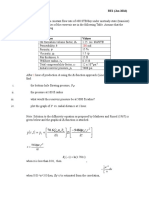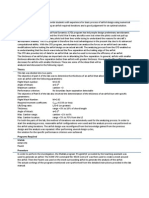MM302E FLUID
MECHANICS II
2015-2016 SPRING
�INTRODUCTION TO DIFFERENTIAL ANALYSIS OF FLUID MOTION
In course Fluid Mechanics I, we developed the basic equations in
integral form for a finite control volume. The integral equations are
particularly useful when we are interested in the gross behavior of a
flow and its effect on various devices. However, the integral approach
does not enable us to obtain detailed point by point data of the flow
field.
To obtain this detailed knowledge, we must apply the equations of fluid
motion in differential form.
In this chapter, we will derive fundamental equations in differential
form and apply this equations to simple flow problems.
EQUATION OF CONSERVATION OF MASS (CONTINUITY EQUATION)
The application of the principle of conservation of mass to fluid flow
yields an equation which is referred as the continuity equation. We shall
derive the differential equation for conservation of mass in rectangular
and in cylindrical coordinates.
MM302 1
�Rectangular Coordinate System
The differential form of the continuity equation may be obtained by applying the
principle of conservation of mass to an infinitesimal control volume. The sizes of
the control volume are dx, dy, and dz. We consider that, at the center, O, of the
control volume, the density is and the velocity is
V u vj wk
The word statement of the conservation of mass is
Net rate of mass flux out Rate of change of mass
through the control surface inside the control volume 0
CS V dA t CV dV 0
The values of the mass fluxes at each of six faces of the control volume may be
obtained by using a Taylor series expansion of the density and velocity
components about point O. For example, at the right face,
x dx
2
2
2
dx 1 dx
2
x 2 x 2! 2
Neglecting higher order terms, we can write
and similarly,
dx
x dx
2
x 2
u dx
u x dx u
2
x 2
MM302 1
�Corresponding terms at the left face are
dx
dx
x dx
2
x 2
x 2
u dx
u dx
u x dx u u
x 2
2
x 2
To evaluate the first term in this equation, we must evaluate
V
dA.
CS
Table. Mass flux through the control surface of a rectangular differential control volume
MM302 1
�The net rate of mass flux out through control surface is
u v w
CS V dA x y z dxdydz
The rate of change of mass inside the control volume is given by
d
V
dxdydz
t CV
t
Therefore, the continuity equation in rectangular coordinate is
u v w
0
x
y
z
t
Since the vector operator, , in rectangular coordinates, is given by
j k
x
y
z
V
0
t
The continuity equation may be simplified for two special cases.
1. For an incompressible flow, the density is constant, the
continuity equation becomes,
V 0
2. For a steady flow, the partial derivatives with respect to time are
zero, that is _________.
Then, .
MM302 1
�Example: For a 2-D flow in the xy plane, the velocity component in the y
direction is given by
v y2 x2 2 y
a) Determine a possible velocity component in the x direction for
steady flow of an incompressible fluid. How many possible x
components are there?
b) Is the determined velocity component in the x-direction also valid
for unsteady flow of an incompressible fluid?
MM302 1
�Example: A compressible flow field is described by
kt
V axi bxyj e
Determine the rate of change of the density at point x=3 m, y=2 m and
z=2 m for t=0.
MM302 1
�Derivation of Continuity Equation Cylindrical Coordinate System
In cylindrical coordinates, a suitable differential control volume is shown
in the figure. The density at center, O, is and the velocity there is
V vr er v e vz ez
Figure. Differential control volume in cylindrical coordinates.
To evaluate
V dA , we must consider the mass flux through each of
CS
the six faces of the control surface. The properties at each of the six
faces of the control surface are obtained from Taylor series expansion
about point O.
MM302 1
�Table. Mass flux through the control surface of a cylindrical differential control volume
The net rate of mass flux out through the control surface is given by
v v
v
V
CS dA vr r r r r z z drddz
The rate of change of mass inside the control volume is given by
dV
rdrddz
t CV
t
In cylindrical coordinates the continuity equation becomes
vr r
vr v
vz
r
r
0
r
z
t
MM302 1
�Dividing by r gives
vr
r
vr 1 v vz
0
r
r
z
t
or
1 (rvr ) 1 ( v ) ( vz )
0
r r
r
z
t
In cylindrical coordinates the vector operator is given by
1
er
e ez
r
r
z
Then the continuity equation can be written in vector notation as
V
0
t
e
er
Note : r e and er
The continuity equation may be simplified for two special cases:
1. For an incompressible flow, the density is constant, i.e.,
2. For a steady flow,
MM302 1
10
�Example: Consider one-dimensional radial flow in the r plane,
characterized by vr = f(r) and v = 0. Determine the conditions on f(r)
required for incompressible flow.
MM302 1
11
�STREAM FUNCTION FOR TWO-DIMENSIONAL INCOMPRESSIBLE
FLOW
For a two-dimensional flow in the xy plane of the Cartesian coordinate systems,
the continuity equation for an incompressible fluid reduces to
u v
0
x y
If a continuous function ( x, y, t ) , called stream function, is defined such that
and
then continuity equation is satisfied exactly, since
u v 2 2
0
x y xy yx
Streamlines are tangent to the direction of flow at every point in the flow field.
Thus, if dr is an element of length along a streamline, the equation of streamline is
given by
V dr 0 (u vj ) (dx dyj ) (udy vdx)k
udy vdx 0
Substituting for the velocity components of u and v, in terms of the stream
function
dx
dy 0
x
y
(A)
At a certain instant of time, t0, the stream function may be expressed as
( x, y, t0 ) . At this instant, the streamfunction
dx
dy
x
y
(B)
Comparing equations (A) and (B), we see that along instantaneous streamline
= constant. In the flow field, 2-1, depends only on the end points of
integration, since the differential equation of is exact.
d 0
MM302 1
12
�Now, consider the two-dimensional
flow of an incompressible fluid
between
two
instantaneous
streamlines, as shown in the Figure.
The volumetric flow rate across
areas AB, BC, DE, and DF must be
equal, since there can be no flow
across a streamline.
2
2
For a unit depth, the flow rate across AB is Q y udy y
Along AB, x = constant and
Q
y2
y1
dy
y
dy . Therefore,
y
dy d 2 1
1
y
For a unit depth, the flow rate across BC is
x2
x2
x1
x1
Q vdx
dx
x
Along BC, y = constant and
Q
x2
x1
dx
x
. Therefore,
dx d 2 1
2
x
Thus, the volumetric flow rate per unit depth between any two
streamlines, can be expressed as the difference between
constant values of defining the two streamlines.
MM302 1
13
�In r plane of the cylindrical coordinate system, the incompressible
continuity equation reduces to
rvr v
0
r
The streamfunction (r, ,t) then is defined such that
vr
1
r
Example: Consider the stream function given by = xy. Find the
corresponding velocity components and show that they satisfy the
differential continuity equation. Then sketch a few streamlines and
suggest any practical applications of the resulting flow field.
MM302 1
14
�MOTION OF A FLUID ELEMENT (KINEMATICS)
Before formulating the effects of forces on fluid motion (dynamics), let
us consider first the motion (kinematics) of a fluid in a flow field. When a
fluid element moves in a flow field, it may under go translation, linear
deformation, rotation, and angular deformation as a consequence of
spatial variations in the velocity.
Figure. Pictorial representation of the components of fluid motion.
MM302 1
15
�Translation
Acceleration of a Fluid Particle in a Velocity Field
Figure. Motion of a particle in a flow field.
Consider a particle moving in a velocity
field.
At time t, the particle is at
a position x, y, z and has a velocity V p V ( x, y, z, t.)
At time t+dt, the particle has moved to a new position, with
coordinates x+dx, y+dy, z+dz, and has a velocity given by
Vp t dt V ( x dx, y dy, z dz, t dt )
The change in the velocity of the particle moving from location r to
r dr is given by
V
V
V
V
dV p
dx p
dy p
dz p
dt
x
y
z
t
Dividing both sides by dt, the total acceleration of the particle is
obtained as
dV p V dx p V dy p V dz p V
ap
Since
then
dx p
dt
u,
dt
dy p
dt
x dt
v
and
y dt
dz p
dt
z dt
dV p
V
V
V V
ap
u
v
w
dt
x
y
z t
MM302 1
16
�Acceleration of a fluid particle in a velocity
field requires a special
DV
derivative, it is denoted the symbol
.
Dt
Thus,
DV
V
V
V V
ap u
v
w
Dt
x
y
z
t
This derivation is called the substantial, the material or particle
derivative.
The significance of the terms,
ap
DV
Dt
total
accelaration
of a particle
V
V
V
u
v
w
x
y
z
convective
acceleration
V
t
local
acceleration
The convective acceleration may be written as a single vector expression
using the vector gradient operator, .
V
V
V
u
v
w
(V )V
x
y
z
Thus,
V
DV
a p (V )V
Dt
t
It is possible to express the above equation in terms of three scalar
equations as
Du
u
u
u u
ax p
u v w
Dt
x
y
z t
Dv
v
v
v v
ayp
u v w
Dt
x
y
z t
Dw
w
w
w w
a zx p
u
v
w
Dt
x
y
z t
The components of acceleration in cylindrical coordinates may be
obtained by utilizing the appropriate expression for the vector operator
Vr V Vr V2
Vr Vr
. Thus
a V
r
r
r
z
t
V V V VrV
V V
a p Vr
Vz
r
r
r
z
t
V V Vz MM302
V V
a z p Vr z
Vz z 1 z
r
r
z
t
rp
17
�Example: The velocity field for a fluid flow is given by
2
V ( x, y, z, t ) x 2 xyj 3ztk
Determine
a) the acceleration vector,
b) the acceleration of the fluid particle at point P(1,2,3) at time
t = 1 sec.
MM302 1
18


